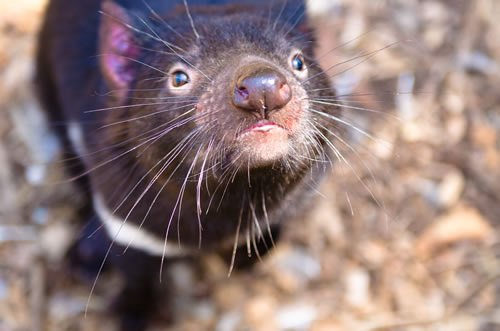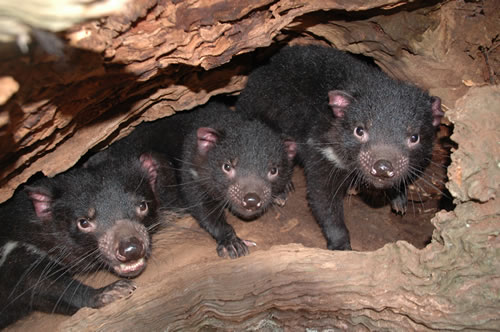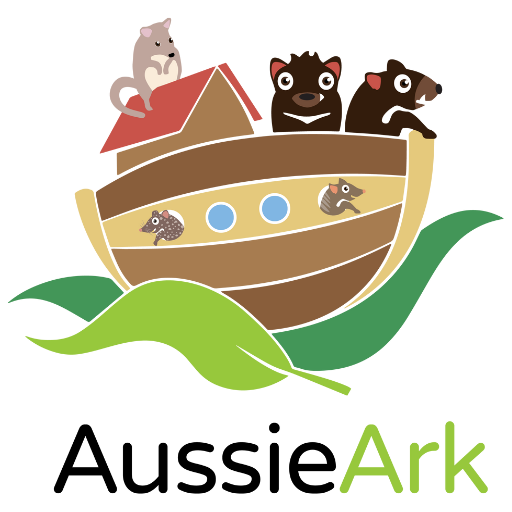26 Jul TASMANIAN DEVIL
Scientific Name: Sarcophilus harrisii
IUCN Conservation status: Endangered
 Description
Description
The Tasmanian devil is the world’s largest surviving marsupial carnivore and was once found on the mainland of Australia, but now only found in Tasmania. The Tasmanian devil typically weighs between 8 – 14 kg (males) or 5 – 9 kg (females) and their body length varies from 57 cm in females to around 65 cm for males. The Tasmanian devil has a very short lifespan. In the wild, a healthy, disease-free devil can live up to 5-6 years old, in captivity they may live up to 8 years.
Habitat
The Tasmanian devil is endemic to Tasmania and is found throughout the island. Tasmanian Devils are found in a wide range of habitats but prefer open forests and woodlands. They live in coastal heath, open dry sclerophyll forest, and mixed sclerophyll rainforest. In fact, almost anywhere they can hide and find shelter by day, and find food at night.
Distribution
The devil became extinct on the mainland some 3,000 years ago – before European settlement, due to being hunted by the Dingo. It is now only found in Tasmania. With no dingoes found in Tasmania, the Tasmanian devil is now the island state’s top predator.
Diet & Behaviour
Tasmanian devils are scavengers rather than hunters and prefer carrion as a result of roadkill or predation by other species. They will eat anything of animal origin, including insects, amphibians, reptiles, birds and mammals. Their sense of smell makes them highly skilled at finding carrion and decaying meat. Their powerful jaws and tooth structure allows them to consume bones, fur and exo-skeleton. The Tasmanian devil has a very short lifespan. In the wild, a healthy, disease-free devil can live up to 5-6 years old, in captivity they may live up to 8 years.
 Reproduction
Reproduction
Tasmanian devils are sexually mature at the age of two years. Their mating period is within the months of March and April. The mother gives birth to two to four young, which attach to the teats in her pouch. The young are pouch-bound for around four months and then remain with the mother for a further five to six months before becoming independent.
Threats
Throughout the 1800s, there was a concerted effort by Tasmanian farmers to eradicate the species, which were thought to kill livestock. Thankfully, the devil did not suffer the same fate as it is a relative to the Tasmanian tiger. Devils are now a protected species, but their survival is threatened by something far more insidious. Devil Facial Tumour Disease (DFTD) is an infectious cancer that only affects Tasmanian devils. DFTD is transmitted through biting, fighting and mating and is one of the only cancers known to spread like a contagious disease. It was first detected in 1996 and since then, 90% of the wild population has gone and the disease is rapidly spreading without any sign of slowing down. Tasmania’s environment stands to face huge loss should the Tasmanian devil become extinct.
How Aussie Ark is helping
Aussie Ark, built off the success of Devil Ark, is Australia’s largest mainland breeding facility for the Tasmanian devil, free from DFTD. The Tasmanian devil is likely to disappear forever if the disease spreads and population decline trends continue. A robust insurance population is the only guarantee for the long-term survival of the species. Without Aussie Ark, the Tasmanian devil stands to disappear, forever.
In addition to this, Aussie Ark is the most cost-effective conservation program operating to save the Tasmanian devil. The cost of raising a Tasmanian devil at Aussie Ark is $2200 per annum. For some other organisations, this cost can be greater than $20,000. Aussie Ark’s hands-off approach helps the devils maintain their wild natural behaviours, meaning they have a greater chance of survival when returned home to Tasmania.
You can help Aussie Ark continue to build the largest mainland insurance population of Tasmanian devils found in Australia, ensuring the survival of an iconic species.


